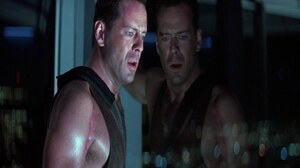Die Hard

If the films of 1987 embodied a clash of cynicism and sincerity, then the films of 1988 decisively tipped the scales toward sincerity. And while these movies did not necessarily break new ground, they took established formulas and honed them to near perfection, embracing familiar genres and elevating them with a level of craftsmanship that bordered on extraordinary. A rare balance of heart and spectacle, the year delivered standout motion pictures that were not only impressive on a technical level but were also deeply human, injecting mainstream cinema with an emotional core that granted these works an uncommon staying power.
Consider Giuseppe Tornatore’s Cinema Paradiso, a film that could have been a simple tale of a boy’s love for movies but instead became a profoundly moving reflection on nostalgia and lost time. Likewise, Penny Marshall’s Big took the well-worn premise of a child suddenly thrust into an adult body and, rather than playing it solely for broad laughs, imbued it with an unexpectedly genuine sense of wonder. Both films resonate emotionally because they never lose sight of the vulnerability at their center, allowing their narratives to become deeply personal experiences for the audience. Each transforms a genre exercise through careful execution, revealing something universal beneath the surface.
Even Robert Zemeckis’ Who Framed Roger Rabbit, which could have been merely an impressive technical showcase in seamlessly blending animation with live-action, surprises with its emotional weight, grounding its dazzling fantasy with a genuine sense of feeling. Meanwhile, John Cleese’s A Fish Called Wanda revitalized the decades-old heist comedy by infusing it with a level of wit and unpredictability few had previously attempted. Each of these releases stands as a testament to how technical mastery and storytelling can work in tandem, proving that even the most traditional setups can feel fresh when executed with intelligence and style.
While these films demonstrate how refinement can be just as thrilling as reinvention, none did so more unexpectedly – or with greater long-term impact – than John McTiernan’s action masterpiece Die Hard. In 1988, Die Hard was an underdog, featuring Bruce Willis – best known as a television star rather than an action hero – in a modestly budgeted, simply premised film that seemed almost small-scale compared to the spectacles of the era. At a time when action protagonists were portrayed as invincible killing machines, the film introduced John McClane, a character who made mistakes, got hurt, and bled; in short, a real person, making his struggle infinitely more compelling.
The brilliance of Die Hard lies in its airtight construction, with every moment serving a purpose. The film transforms its confined space into a crucible of escalating tension, forcing McClane to rely on ingenuity rather than strength. He is not equipped to battle the criminals, so he must improvise his strategy, crawling through vents, using a fire hose to escape, and scrawling taunting messages on corpses. Every challenge builds naturally upon the last, and every injury he sustains matters, reinforcing the stakes and keeping the action immediate and visceral.
Before Die Hard, action villains were often interchangeable thugs, but Hans Gruber, brought to life by Alan Rickman in a performance of effortless menace, redefined the archetype. Instead of brute force, he wields charm, intelligence, and dry humor, making him charismatic as well as dangerous. Gruber is not a terrorist; he is a thief masquerading as one, a refined, almost-likable sociopath, and his sophistication makes him all the more terrifying. His meticulously planned heist mirrors the film’s own precise structure, elevating Die Hard beyond a simple action spectacle. By giving the hero an adversary as cunning as he is ruthless, the film resets audience expectations.
The enduring influence of Die Hard cannot be overstated. It rewrote the rules of action filmmaking, established the template for the everyman hero, and inspired countless direct imitators. Yet, while many borrowed its setup, few understood what made it truly great: its attention to detail, its commitment to character development, and its mastery of spatial geography. The layout of Nakatomi Plaza is not just a backdrop; it is an essential component of the action, reinforcing the film’s tension with its single-location focus, every floor and corridor shaping the flow of the story and each set piece.
Today, Die Hard remains the gold standard for action cinema. While modern blockbusters have increasingly leaned on CGI-driven spectacle in place of grounded, practical effects, few have matched its level of craftsmanship. The film expertly balances humor and intensity, ensuring audiences are constantly engaged but never overwhelmed. Beneath its high-stakes thrills lies a surprising warmth, optimism, and even a touch of sentimentality. It is a film that has aged almost perfectly, its blend of suspense, wit, and intelligence keeping it just as compelling and rewatchable now as it was when it first hit movie theater screens.
Looking back, 1988 was not a year of radical transformation. It did not introduce new genres or upend the conventions of cinema. Instead, it was a year of refinement, proving that mainstream movies could offer both spectacle and substance. The defining films of the year were not just technically accomplished; they resonated emotionally, offering audiences something to remember beyond their action sequences. Filmmakers took established forms and delivered stunning iterations, demonstrating that true innovation does not always require reinvention. Sometimes, great films succeed not by rewriting the rules, but by perfecting them and setting a new standard for others to follow.
And as a footnote, Terry Gilliam’s The Adventures of Baron Munchausen, a visually extravagant period fantasy blending absurd humor, surreal imagery, and elaborate set pieces, was released in the spring of 1988. Chronicling the legendary Baron’s outlandish journeys, the film’s stunning practical effects create a dreamlike atmosphere, though beneath the whimsy lies a melancholic undercurrent – the struggle of imagination against an encroaching, joyless rationality. Despite its imaginative scope, the production was plagued by financial woes and a troubled release, resulting in commercial failure. Yet, the film endures as a testament to Gilliam’s signature flair: a messy, defiant, and intoxicating embrace of creative excess.
